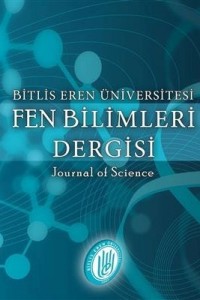Arabidopsis thaliana Bitkisi ile Pseudomonas putida Bakterisi Arasındaki Etkileşimin in vitro Koşullarda Belirlenmesi
Öz
A.
thaliana genomu dizilenmiş genetik, biyokimyasal ve
biyoteknolojik çalışmalarda yaygın olarak kullanılan model bir bitkidir. P. putida bakterisi ise bitki köklerinde
kolonize olabilen, genomu dizilenmiş, bitki büyümesini teşvik eden, patojenik
olmayan ve bitki-bakteri etkileşimlerinin anlaşılması için model olmaya aday
rizosferik bir bakteridir. Bu nedenle, bu çalışmanın amacı A. thaliana’nın in vitro
çimlenmesi ve fideciklerinin büyümesi üzerine P. putida’nın etkisinin değerlendirilmesidir. Bu amaçla, yüzey
sterilasyonu yapılmış A. thaliana
tohumlarının inokülasyonu için 2x103-2x105 CFU/ml
aralığındaki bakteri konsantrasyonları pipetleme metodu kullanılarak denenmiştir.
Ayrıca, aynı bakteriyel süspansiyonlar 3, 5, 10 ve 14 günlük in vitro koşullarda çimlendirilmiş
fideciklere de uygulanmıştır. Bu araştırma alanı, bitki-bakteri
etkileşimlerinde inokülasyonun öneminin anlaşılmasına önemli bir yarar ve bunun
yanı sıra daha sonraki kapsamlı çalışmalar için bir katkı sağlayacaktır.
Dahası, sonrasında bitki-bakteri etkileşimleri aracılığıyla biyoremediasyonun
başarılmasına yardımcı olacaktır.
Anahtar Kelimeler
Kaynakça
- Refrans 1:Buee M., De Boer W., Martin F., van Overbeek L., Jurkevitch E. 2016. The rhizospherezoo: an overview of plant-associated communities of microorganisms, including phages, bacteria, archaea, and fungi, and of some of their structuring factors, Plant Soil, 321:189-212.
- Referans2: Berendsen R.L., Pieterse C.M.J., Bakker P.A.H.M. 2012. The rhizosphere microbiome and plant health. Trends in Plant Science, 17: 478-86.
- Referans3: Vorholt, J.A. 2012. Microbial life in the phyllosphere. Nature Review Microbiology, 10, 828-40.
- Referans4: Doornbos R.F ., Van Loon L.C., Bakker P.A.H.M. 2012. Impact of root exudates and plant defense signaling on bacterial communities in the rhizosphere, Agronomy for Sustainable Development, 32: 227-243.
- Referans5:Pieterse CMJ, Zamioudis C, Berendsen RL, Weller DM, Van Wees SCM, Bakker PAHM. 2014. Induced systemic resistance by beneficial microbes, Annual Review of Phytopathology, 52: 347-375.
- Referans6:Espinosa-Urgel M., Salido A., Ramos J.L. 2000. Genetic analysis of functions involved in adhesion of Pseudomonas putida to seeds, Journal of Bacteriology, 182: 2363-2369.
- Referans7:Molina L., Ramos C., Duque E., Ronchel M.C., Garcia J.M., Wyke L et al. 2000. Survival of Pseudomonas putida KT2440 in soil and in the rhizosphere of plants under greenhouse and environmental conditions, Soil Biology and Biochemistry, 32: 315-321.
- Referans8:Weller D.M. 2007. Pseudomonas biocontrol agents of soilborne pathogens: looking back over 30 years, Phytopathology, 97: 250-256.
- Referans9:Nelson K.E., Weinel, C., Paulsen I.T., Dodson R.J., Hilbert H., Martins dos Santos V.A.P., ... & Brinkac L. 2002. Complete genome sequence and comparative analysis of the metabolically versatile Pseudomonas putida KT2440. Environmental Microbiology, 4: 799-808.
- Referans10:Jiménez J.I., Miñambres B., García J. L., & Díaz, E. 2002. Genomic analysis of the aromatic catabolic pathways from Pseudomonas putida KT2440. Environmental Microbiology, 4: 824-841.
- Referans11:Wu X., Monchy S., Taghavi S., Zhu W., Ramos J., Van der., Lelie D. 2010. Comparative genomics and functional analysis of niche-specific adaptation in Pseudomonas putida. FEMS Microbiology Reviews, 35:299-323.
- Referans12:Matilla Miguel A., et al. 2010. Pseudomonas putida KT2440 causes induced systemic resistance and changes in Arabidopsis root exudation, Environmental Microbiology Reports 2.3: 381-388.
- Referans13:Neal A.L., Ton, J. 2013. Systemic defense priming by Pseudomonas putida KT2440 in maize depends on benzoxazinoid exudation from the roots, Plant Signaling & Behaviour, 8:e22655.
- Referans14:Koornneef M and Meinke D., 2010. The development of Arabidopsis as a model plant, The Plant Journal, 61(6): 909-921.
- Referans15:Dodds P.N., Rathjen J.P. 2010. Plant immunity: towards an integrated view of plant-pathogen interactions, Nature Reviews Genetics, 11: 539-548.
- Referans16:MacLean AM., Sugio A., Makarova OV., Findlay KC., Grieve VM., Tóth R., Nicolaisen M., Hogenhout SA. 2011. Phytoplasma effector SAP54 induces indeterminate leaf-like flower development in Arabidopsis plants, Plant Physiology, 157: 831–841.
- Referans17:Ouibrahim Laurence and Carole Caranta. 2013. Exploitation of natural genetic diversity to study plant-virus interactions: what can we learn from Arabidopsis thaliana? Molecular plant pathology, 14.8, 844-854.
- Referans18:Windram, O., Penfold, C.A. and Denby K.J. 2014. Network modeling to understand plant immunity. Annual review of phytopathology, 52.
- Referans19:Pieterse CMJ., Zamioudis C., Berendsen RL., Weller DM., Van Wees SCM., Bakker PAHM. 2014. Induced systemic resistance by beneficial microbe, Annual Review of Phytopathology, 52, 347-375.
- Referans20:Murashige T., Skoog, F. 1962. A revised medium for rapid growth and bio-assays with tobacco tissue cultures, Physiologia Plantarum, 15(3): 473-497.
- Referans21:Zannoni, D., Venturoli G., and Daldal F. 1992. The role of the membrane bound cytochromes of b- and c-type in the electron transport chain of Rhodobacter capsulatus. Archieves of Microbiology, 157, 367–374.
- Referans22:Batool M. 2018. Determination of interaction between Arabidopsis thaliana and putative endophytic bacterium associated with fraser photinia, Gebze Technical University, Department of Molecular Biology and Genetics, Master Thesis, 64 pages, Kocaeli.
- Referans23:Ishiga Y., Ishiga T., Uppalapati S.R. and Mysore, K.S. 2011. Arabidopsis seedling flood-inoculation technique: a rapid and reliable assay for studying plant-bacterial interactions, Plant Methods, 7:32
- Referans24:Akkaya, Ö., Arslan E., Özden Çiftçi Y. 2018. Influence of Pseudomonas putida on in vitro germination and seedling growth of Arabidopsis thaliana, 2nd International Congress on Advances in Bioscience and Biotechnology (ICABB), Page 47, June 26-30, Podgorica, Montenegro.
Ayrıntılar
| Birincil Dil | Türkçe |
|---|---|
| Bölüm | Araştırma Makalesi |
| Yazarlar | |
| Yayımlanma Tarihi | 28 Haziran 2019 |
| Gönderilme Tarihi | 12 Aralık 2018 |
| Kabul Tarihi | 29 Nisan 2019 |
| Yayımlandığı Sayı | Yıl 2019 Cilt: 8 Sayı: 2 |


